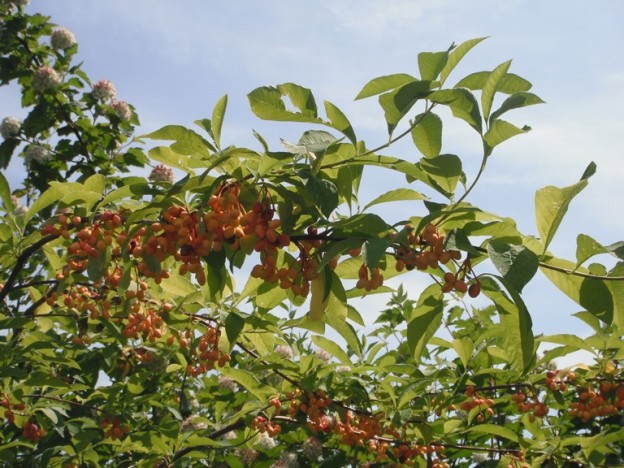Indian Plum The Rose Family–Rosaceae
Oemleria cerasiformis (Torr. & A. Gray ex Hook & Arn.) Landon
(ohm-LAIR-ee-uh sir-ASS-ih-form-iss)
Names: The genus is named after Augustus Gottlieb Oemler (1773-1852), a German naturalist from Savannah, Georgia, who was the first to collect the species. Cerasiformis means cherry-shaped. The species is also known as Osmaronia cerasiformis or Nuttallia cerasiformis. Osm- is a Greek root meaning “smelly;” aronia is the genus of chokeberries. Other common names include Osoberry, Oregon Plum, Squaw Plum, Indian Peach, Bird Cherry, and Skunkbush.
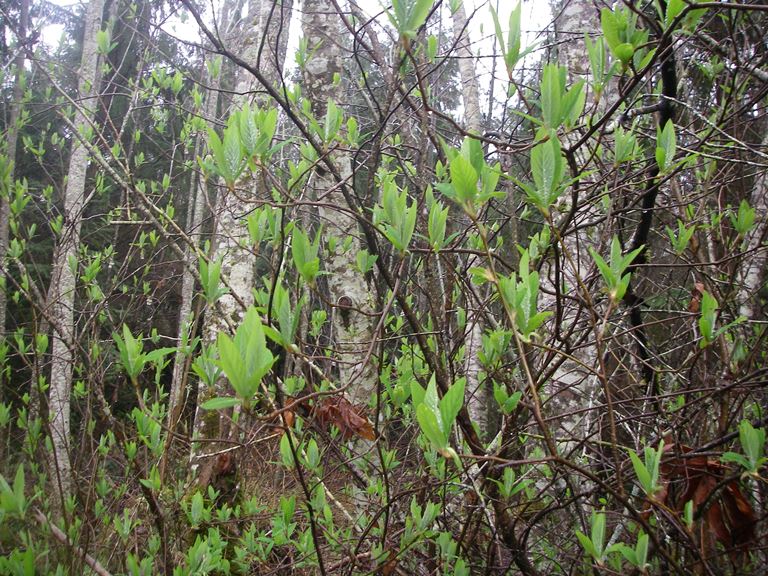
Indian Plum leafs out early in Sprin
Relationships: Indian Plum is the only species in the genus Oemleria. It bears a stone fruit or drupe similar to fruits in the related genus, Prunus which includes plums, cherries, apricots, peaches, and almonds.
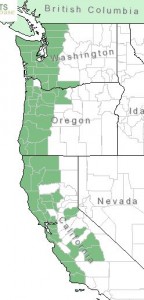
Distribution of Indian Plum from USDA Plants Database
Distribution: It is native from the area around Vancouver and Victoria, British Columbia to Santa Barbara County in California on the west slope of the Cascades and Sierra Nevadas.
Growth: Indian Plum grows 4.5-20 feet (1.5-7m)
Habitat: It grows in dry to moist open woods and streambanks. Wetland designation: FACU, It usually occurs in non-wetlands, but occasionally is found on wetlands.
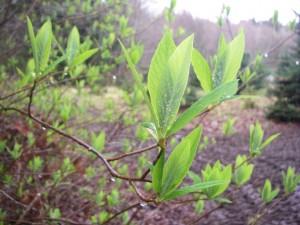 Diagnostic Characters: Its leaves are bright green in spring, lance-shaped, and entire (not toothed); and smell like cucumber when crushed. Small, five-lobed flowers are born in drooping clusters, usually appearing before the leaves. Each flower is white with a green calyx. They are said to have an unusual fragrance
Diagnostic Characters: Its leaves are bright green in spring, lance-shaped, and entire (not toothed); and smell like cucumber when crushed. Small, five-lobed flowers are born in drooping clusters, usually appearing before the leaves. Each flower is white with a green calyx. They are said to have an unusual fragrance 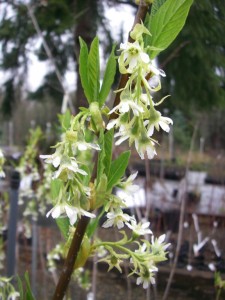 “something between watermelon rind and cat urine.” Others compare it to almonds. Some sources report that the female flowers have a pleasant fragrance, but the male flowers are unpleasant. The fruit are like small plums. Immature fruit is peach-colored, mature fruit is purple or bluish-black. Since Indian Plum is dioecious, you need to a have a female plant with nearby males for it to bear fruit. In natural populations, there are usually more males than females, due to a higher mortality of females. Males often flower at an earlier age than females; females have a slower growth rate.
“something between watermelon rind and cat urine.” Others compare it to almonds. Some sources report that the female flowers have a pleasant fragrance, but the male flowers are unpleasant. The fruit are like small plums. Immature fruit is peach-colored, mature fruit is purple or bluish-black. Since Indian Plum is dioecious, you need to a have a female plant with nearby males for it to bear fruit. In natural populations, there are usually more males than females, due to a higher mortality of females. Males often flower at an earlier age than females; females have a slower growth rate.
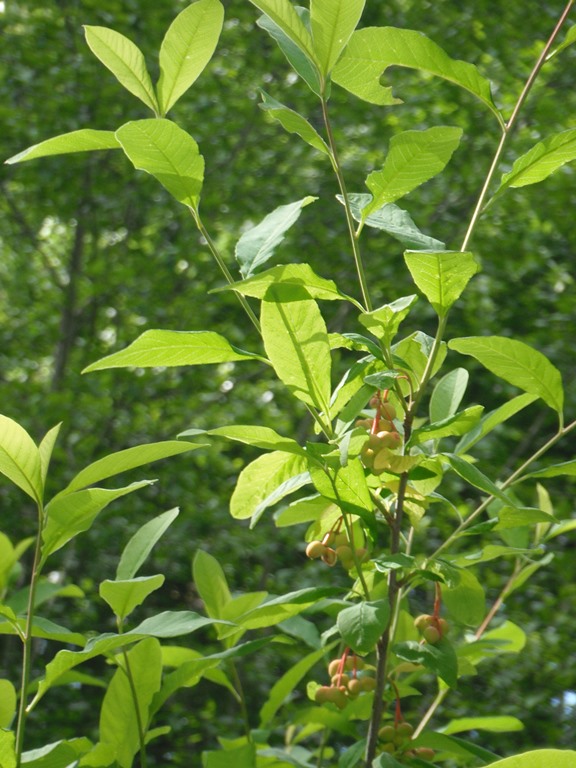
Love the spring green color!
In the Landscape: No other native shrub ushers in spring as splendidly as Indian Plum with its cheerful greenish-white flower clusters and spring green foliage. Best in an open woodland garden, its flowers and new foliage brighten up an otherwise dreary late winter day. Its graceful, arching branches are prettiest in the shade of alders and maple. Later in the summer it is not as distinctive, blending in with other shrubs, appearing somewhat like a willow. Because of its thicket-forming, suckering habit, it is not a good choice for a formal garden, but is a great choice for greenbelts and reclamation sites.
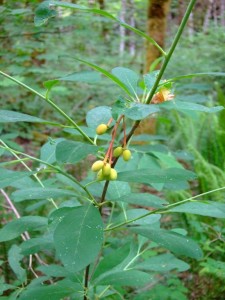
In the summer, the leaves are a darker green.

It is best in a woodland setting.
Phenology: Bloom time: February-April. Fruit ripens: May-July.
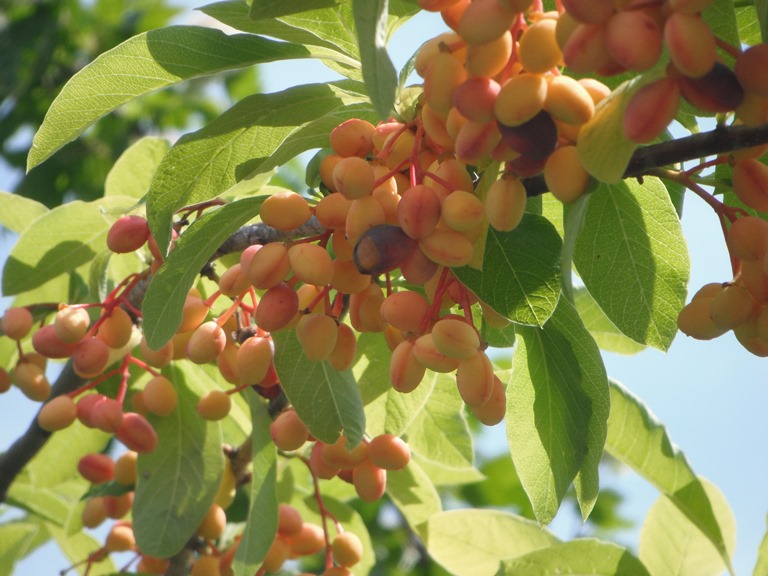
Fruit turns dark purple when ripe.
Propagation: Soak seeds in water for 24 hours and stratify 120 days at 40º F (4º C). Softwood or semi-hardwood cuttings may be taken in late summer. Suckers around the base of shrub may be divided in fall or winter.
Use by People: Indian Plums were eaten in small quantities fresh, cooked, or dried by Native Americans. Flavor of unripe fruit is bitter and astringent, but they become more palatable when they are fully ripe. Natives also used the twigs and bark for various medicinal uses. Leaves, seeds and even fruit may contain small quantities of hydrogen cyanide, and should therefore only be consumed in small quantities.
Use by Wildlife: Indian Plums are highly attractive to birds such as cedar waxwings and are also eaten by mammals. Flowers are pollinated by hummingbirds, butterflies, native bees and other insects.
Links:
Consortium of Pacific Northwest Herbaria
WTU Herbarium Image Collection, Plants of Washington, Burke Museum
E-Flora BC, Electronic Atlas of the Flora of British Columbia
Jepson Eflora, University of California
Ladybird Johnson Wildflower Center
Native Plants Network, Propagation Protocol Database
Native American Ethnobotany, University of Michigan, Dearborn

